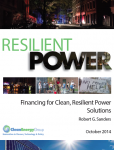The Clean Energy Group (CEG) has published a paper describing mechanisms with potential for providing low-cost, long-term financing for resilient power.
The paper, titled ‘Financing Options for Clean, Resilient Power Solutions,' identifies financing tools that: can be used to implement projects; will attract private capital; and reduce the cost of solar and resilient power installations.
 30 October 2014: The Clean Energy Group (CEG) has published a paper describing mechanisms with potential for providing low-cost, long-term financing for resilient power. The paper, titled ‘Financing Options for Clean, Resilient Power Solutions,‘ identifies financing tools that: can be used to implement projects; will attract private capital; and reduce the cost of solar and resilient power installations.
30 October 2014: The Clean Energy Group (CEG) has published a paper describing mechanisms with potential for providing low-cost, long-term financing for resilient power. The paper, titled ‘Financing Options for Clean, Resilient Power Solutions,‘ identifies financing tools that: can be used to implement projects; will attract private capital; and reduce the cost of solar and resilient power installations.
CEG is a US-based nonprofit organization. President Lew Milford discusses how, on the East Coast of the US, Superstorm Sandy knocked out electricity grids and left millions of people in public housing, senior centers, hospitals and shelters for weeks without power. According to Milford, “surprisingly good news” came out of the power outages because local governments did not return to “business as usual.” Instead, they recognized that Sandy signaled a “new normal,” and that conditions are changing, storms are becoming more frequent and severe, and officials cannot “sit back and do nothing.”
Milford describes an emerging strategy to deal with natural disasters and the power outages they cause known as “Resilient Power.” He explains that at the state and community level, policy is transitioning away from back-up diesel generators (which failed during Sandy) and towards technologies like solar photovoltaics (PV) plus energy storage (solar + storage), microgrids and fuel cells as future choices. While emphasizing the importance of these technologies, he said resilient projects must be financed at scale with public and private money, and accessible to both high and low-income communities.
The CEG paper tackles this issue head-on, describing how implementing resilient power technologies requires access to capital on terms that make projects economically feasible. The paper explores how financing options, such as bond financing, credit enhancement, clean energy financial institution initiatives, and public and private ownership structures, can support resilient power technologies. It also focuses on resilient power financing for low-income communities and affordable housing projects, and goes beyond the conventional state grant and loan models, urging the use of innovative financing models that are available to municipalities.
The report itself includes sections on, inter alia: the need for resilient power; the need for clean, resilient power finance; innovative financing models for resilient power; reducing risk and increasing clean energy; emerging markets for resilient power technologies; resilient power for vulnerable communities and the disabled; and how cities can use solar energy to become more power resilient.
The CEG intends to continue pushing for a combination of new public resources and innovative, new financing models, as well as established finance tools used in new ways, which can then be applied to resilient power for critical facilities and infrastructure.
Founded in 1998, the CEG is an advocacy organization that works to advance innovative clean energy technology, finance, and policy in the US and internationally, and has served as the Secretariat for the UNEP Sustainable Energy Finance Alliance. [CEG Blogpost] [Publication: Financing Options for Clean, Resilient Power Solutions]